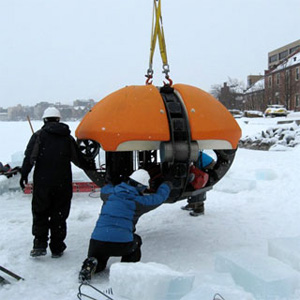[/caption]
A submersible probe that could possibly be used on Jupiter’s icy moon, Europa is taking the next step to test its capabilities. The Environmentally Non-Disturbing Under-ice Robotic Antarctic Explorer, also known as ENDURANCE, will swim untethered under ice, and collect data to create three-dimensional maps of underwater environments. The probe also will take samples of microbial life. Earlier this year, it operated successfully in a 25 meter frozen lake in Wisconsin, USA. Now it will plunge under a permanently ice covered lake in Antarctica that is 40 meters deep. ENDURANCE isn’t like the Mars Rovers or other remote-operated probes. Once deployed, it’s on its own to systematically explore, take water samples, and find its way back. “It will have to think on its own,” said Peter Doran, an Earth scientist at the University of Illinois in Chicago.
In the February 2008 test, ENDURANCE successfully found its way around the bottom of the lake and back to the hole that drilled in the ice to get the probe in and out of the lake. It also demonstrated that its electronics functioned perfectly well in cold water.
At Lake Bonney in Antarctica, ENDURANCE will not only map the lake and explore its biology, but also take a close look at the base of a feature called Blood Falls, where reddish, iron-containing salts spill out of the face of a glacier at the lake’s upper end.
If all goes well the next test would have the probe or an improved version descend through 3.5 km of ice to one of the world’s largest, deepest and most mysterious lakes, Lake Vostok, also in Antarctica.
But even that pales in comparison to what a probe might encounter at Europa. Scientists believe that Europa’s ocean could be up to 100 kilometers deep, under 6 kilometers of ice.
Hot water drills will bore a hole for ENDURANCE to enter the water in Antarctica. If all goes well, the probe will be tested again in 2009.
But many hurdles remain before an underwater vehicle could possibly head to Europa. Presently, Endurance is too massive to send on interplanetary travel. Engineers will also have to come up with a way to drill through Europa’s icy crust and lower the sub safely through the ice.
But many scientists feel that an orbiting spacecraft would be the best way to study Europa, before sending an underwater probe. The Jet Propulsion Laboratory is currently working on a concept called the Europa Explorer which would deliver a low orbit spacecraft to determine the presence (or absence) of a liquid water ocean under Europa’s ice surface. It would also map the surface and subsurface for future exploration.
Source: COSMOS


This is great. One small hop-skip-jump for man & his robots! Good luck to him/her/it. ( Ships are ‘she’, what are robot explorers called? The one annoying thing is that I started writing a Sci-Fi story a while ago about intelegent robots exploring Europa & Antarctica. Too late I’ll just have to ditch this story line ! Or write faster. They have not discovered the aliens from Io also exploring Europa yet. Watch this space!.
( a low orbit spacecraft to determine the presence (or absence) of a liquid water ocean under Europa’s ice surface.)
So they build a robot to go explore an ocean that they dont know if it even exists?
thats smart…
ALL THESE WORLDS ARE YOURS EXCEPT EUROPE
ATTEMPT NO LANDING THERE
USE THEM TOGETHER
USE THEM IN PEACE
LLDIAZ, exploring the antarctic lakes is a scientific end in itself. I imagine the robot was built for that as much as anything.
Also, while we’re not yet certain that there’s a subsurface ocean on Europa, the chances (from what we’ve observed so far) appear very high.
My question is, Has anyone ever even detected the elements hydrogen and oxygen, on Europa yet? If not, it might make for a more sound judgement, financially speaking, to first see if the elements themselves are even there. If their not, there wont be no point for even bothering with sending a sub there to look for something that has to have those elements to exist.
I am going out on a limb here, but is the 3.5 km of ice on lake Vostok a typo or is it one of the ‘lakes’ that reside under the ice sheet?
Another thought. The pressure that must reside under 6 km of ice even on the reduced gravity load of Europa must be intense. The pressure shell required will be heavy, even with the use of ceramics etc. Combine that with the nuclear reactor to produce enough heat to melt the channel for the sub to descend through and you have a honking big mass to throw towards Jupiter.
Not to mention the anti nuclear folks are going to go over the top on this one.
On a positive note, maybe we actually have a use for the Ares V rocket after all.
Jamie
Wouldn’t it be great if life were discovered on another body during Obamas first term!
@Jamie Kitchen
3.5km is about correct. Lake Vostok is really deep down below.
there may be ways to go without too much pressure protection if there are no humans to protect. i think they can build the equipment such that is works under high pressure.
I am one of the “anti nuclear folks” (in my case, german greens), because I think it is too dirty and dangerous to be used for terrestrial power production, where there are other possibilities. In space exploration there are none (for the most part), so I think it’s inevitable there. They should try not to blow up on launch though…